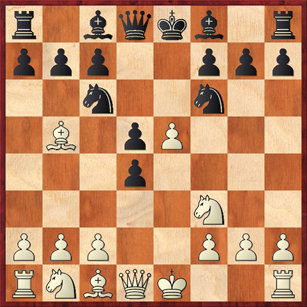In my post on November 9, I talked about my aversion to giving lectures on openings, because I think most people study openings too much. However, I just recorded the last lecture in my series on the Two Knights Defense, and I have to say I really enjoyed doing the research for it. I lectured about a line that has always been a problem for me, called the Modern Variation. It begins 1. e4 e5 2. Nf3 Nc6 3. Bc4 Nf6 4. d4 ed 5. e5 d5 6. Bb4, reaching the position below:
I’ve never really liked the positions Black gets out of this, and it wasn’t until I worked on this lecture that I figured out why. It’s because White can play in pure Nimzovichian style, blockading the position and only then, after Black is completely tied up, launching an attack on the kingside. Nimzovich’s approach to chess was very much like a spider’s approach to killing a fly. The spider could never hope to move as fast as a fly, so first he catches him in a web, and then he wraps him up good and tight so that he can’t move. Only then does he poison the fly and eat his meal.
I subtitled my lecture “The Nimzo-Two-Knights” to emphasize how much White’s strategy owes to Nimzovich. If you want to know what I recommend doing about it as Black, you’ll have to listen to my lecture. Basically, though, if you’re a fly, you have two strategies.
- Don’t fly into the spider’s web in the first place.
- Draw out all of the spider’s venom so that even after he wraps you up, he can’t kill you.
In my lecture I present one subvariation of each type. Which strategy would you prefer?




{ 2 comments… read them below or add one }
This is pretty cool, I’m always surpriced when I watch the two Knights series how much fun 1.e4 e5 can be, because I always thought those lines would be boring/lacking dynamic since I didn’t know the theory and didn’t know how to unbalance the position and create targets and get ideas for what to play. Somewhere around summer next year I’m going to start playing it I think, by then I’ll have hopefully learned my other openings. 😀
It would be fun to have a game from the Black side if my opponent got greedy and accepted the Pawn sac for example and allowed Black to storm the Kingside with all those pretty mates. But it’d also be fun to play the White side, knowing to just reject the sacrifices and play strategically. There’s a kind of beautiful logic in blocking Black’s Queenside Pawn majority so he has no counterplay when the White’s four Kingside Pawns storm forward. 😀
I guess it also depends on what kind of opponent you’re up against. If it’s a guy who’s materialistic, it’d be a good try with Black, I think (because then he might take the sacrifice, unless he’s booked up). As White I think I’d play it just to hone my strategic skills. I’m starting to really enjoy the challenge of learning how to maneuver pieces around and creating plans and not straying from them just because the opponent makes shallow threats/offers a tempting sacrifice. But also from the Black side, it would be fun to work with exploiting the power of the two Bishops, and get the white-squared one to a6 if the opponent is unaware. It’s a great feeling when you succeed in making the Bishops work well together in a game, because they’re often neglected at my level, looking (and serving as) like big fat Pawns.
Oh, you say in the end that this lecture concludes the series. I wouldn’t mind seeing more with the two Knights Defense, though. Not necessarily a theoretical video again, but if you play the line in a tournament game, it’d be a cool idea to see it annotated and made into a lecture. 😛
Hi Carina,
I think that double e-pawn openings get a bad reputation because so many beginning players use the unimaginative 1. e4 e5 2. Nf3 Nc6 3. Bc4 Bc5 4. d3 d6. But the Two Knights is a great way to unbalance the position and avoid being bored to death. In particular, I think that the Modern Variation of the Two Knights has so much strategic richness and variety for both sides that it could (in an alternate universe) be just as mainstream an opening as the Ruy Lopez.